Standard [WITHDRAWN] Article is not orderable
ASTM D 8243:2019
Standard Test Method for Determination of APS Reductase to Estimate Sulfate Reducing Bacterial Bioburdens in Water - Enzyme-Linked Immunosorbent Assay Method
- Publication date
- 2019
- Original language
- English
- Pages
- 9
- Publication date
- 2019
- Original language
- English
- Pages
- 9
- DOI
- https://dx.doi.org/10.1520/D8243-19
Product information on this site:
Quick delivery via download or delivery service
Buy securely with a credit card or pay upon receipt of invoice
All transactions are encrypted
Short description
1.1 This test method provides a protocol for using enzyme-linked immunosorbent assay (ELISA) technology to test water samples for the enzyme adenosine 5'-phosphosulfate reductase (APSr) concentration. 1.1.1 APSr is present in all known sulfate reducing protists (SRP - sulfate reducing bacteria - SRB - and sulfate reducing archaea - SRA). 1.1.2 As reported in U.S. Patent 4,999,286, APS reductase concentration can be used as a surrogate parameter for estimating SRA bioburdens ( Appendix X1 compares results from Test Methods D8243 , D4412 , and quantitative polymerase chain reaction - qPCR - testing). 1.2 This test method has been validated in tap water, oilfield produced water (salinities ranging from 100 g L-1 to 600 g L-1), and fuel-associated water (commonly referred to as bottoms-water). 1.3 This test method detects APS reductase semi-quantitatively in the range of 0.001M to 0.1M - correlating to 102 SRP/mL to 106 SRP/mL. 1.3.1 As described in Appendix X2 test method sensitivity can be increased 10-fold to 100-fold. However, the precision statistics provided in X apply only to 10-mL specimens. 1.4 The values stated in SI units are to be regarded as standard. No other units of measurement are included in this standard. 1.5 This standard does not purport to address all of the safety concerns, if any, associated with its use. It is the responsibility of the user of this standard to establish appropriate safety, health, and environmental practices and determine the applicability of regulatory limitations prior to use. Some specific hazards statements are given in Section 9 on Hazards. 1.6 This international standard was developed in accordance with internationally recognized principles on standardization established in the Decision on Principles for the Development of International Standards, Guides and Recommendations issued by the World Trade Organization Technical Barriers to Trade (TBT) Committee.
ICS
07.100.20
DOI
https://dx.doi.org/10.1520/D8243-19
Loading recommended items...
Loading recommended items...
Loading recommended items...
Loading recommended items...

